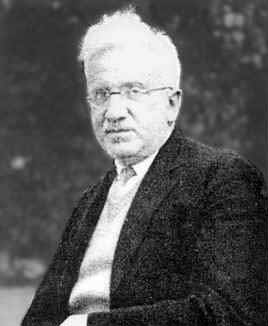


 تاريخ الرياضيات
تاريخ الرياضيات
 الرياضيات في الحضارات المختلفة
الرياضيات في الحضارات المختلفة 
 الرياضيات المتقطعة
الرياضيات المتقطعة
 الجبر
الجبر
 الهندسة
الهندسة 
 المعادلات التفاضلية و التكاملية
المعادلات التفاضلية و التكاملية 
 التحليل
التحليل
 علماء الرياضيات
علماء الرياضيات |
Read More
Date: 6-6-2017
Date: 16-6-2017
Date: 9-6-2017
|
Died: 13 February 1947 in Copenhagen, Denmark

Erich Hecke's father, Heinrich Hecke, was an architect. Erich attended primary school at Buk before going to Posen for his secondary school studies. He graduated from secondary school in 1905 and in that year he entered the University of Breslau.
Following the tradition in Germany at that time Hecke did not complete his studies at a single university, but moved to several different universities during the course of his studies. After Breslau he worked under Edmund Landau at Berlin and then from there he went to Göttingen where he worked under Hilbert. Hecke was awarded his doctorate at Göttingen in 1910 for a dissertation Zur Theorie der Modulfunktionen von zwei Variablen und ihrer Anwendung auf die Zahlentheorie which had been supervised by Hilbert.
Hecke remained at Göttingen where he was appointed as an assistant to Hilbert and Klein. He submitted his habilitation to the University of Göttingen in 1912 and earned the right to teach there, which indeed he did as a Privatdozent. In 1915 Hecke was appointed to a chair at the University of Basel but, three years later, he returned to a chair of mathematics at Göttingen.
One might have imagined that Hecke would have been happy to stay at Göttingen but, having been there for only one year, he accepted the chair of mathematics at Hamburg in 1919. The university was founded in 1919 and so he would have had the opportunity to influence the new institution in a way which would not have been possible in an older establishment. There was then a rather strange episode regarding chairs of mathematics at both Berlin and Göttingen.
Carathéodory, who went from Göttingen to Berlin in 1918 left in the following year and, at the request of the Greek government, he took up a post at the University of Smyrna. This left Berlin trying to fill Carathéodory's chair and Göttingen trying to fill Hecke's chair both in 1919. The two universities drew up very similar lists of possible mathematicians to fill the posts. Brouwer and Weyl topped the list for the chair at both universities but both turned down the offers they received from each of Göttingen and Berlin. Courant then accepted the offer of Hecke's chair at Göttingen while Berlin, having been refused by their third choice Herglotz, tried to entice Hecke to leave Hamburg and accept the chair at Berlin. Hecke, however, was happy with his new post at Hamburg and turned down the offer from Berlin. He would remain at Hamburg from the rest of his career.
The paper [5] is a published version of a talk given by Schoeneberg at a conference organised in Hamburg to celebrate the 100th anniversary of Hecke's birthday in 1987. Schoeneberg describes Hecke's contributions to a number of topics which he lists as follows: Hilbert modular functions, Dedekind zeta functions, arithmetical notions and methods, elliptic modular forms of level N, algebraic functions, Dirichlet series with functional equation, Hecke-operators Tn, and physics where he made contributions to the kinetic theory of gases.
Hecke's best work was in analytic number theory where he continued work of Riemann, Dedekind and Heinrich Weber. Complex multiplication and modular forms had been treated in the 19th century by Kronecker and Heinrich Weber, who discovered their link with class field theory. For his doctoral work Hilbert suggested to Hecke that he extend Kronecker's ideas to curves of genus 2. Although Hecke achieved important results following this line of investigation, he considered that his attempts had been unsuccessful. However it was highly successful in the sense that the results which Hecke obtained were to lead him to further major discoveries.
Hecke's contributions in number theory are discussed in detail in [2]. He studied the Riemann zeta function, and its extension to arbitrary number fields, discovering important results. He used these results to simplify theorems in class field theory. He then introduced the new concept of "Grössencharakter" and the corresponding L-series, to which he extended the properties of analytic continuation he had proved for the zeta functions in 1917. He discovered the decomposition laws for the divisors of discriminants for class fields.
Probably Hecke's most important work was in 1936 with his discovery of the properties of the algebra of Hecke operators and of the Euler products associated with them. He [1]:-
... discovered new connections between prime numbers and analytic functions and new rules for the representation of natural numbers through positive integral quadratic forms of an even number of variables.
Hecke married and had a son who tragically died young. Hecke himself died of cancer before reaching his 60th birthday.
Articles:



|
|
|
|
للعاملين في الليل.. حيلة صحية تجنبكم خطر هذا النوع من العمل
|
|
|
|
|
|
|
"ناسا" تحتفي برائد الفضاء السوفياتي يوري غاغارين
|
|
|
|
|
|
|
قسم الشؤون الفكرية يصدر كتابًا عن فن إدارة الحياة اليومية
|
|
|